Chapter 9: From trial balance to financial statements
Chapter learning objectives
Upon completion of this chapter you will be able to:
- illustrate the process of adjusting the financial statements for accruals and prepayments, depreciation, irrecoverable debts and the allowance for receivables.
1 Trial balance
In this chapter we will bring together the material from theprevious chapters and produce a set of financial statements from a trialbalance.
This will involve adjusting for the following items:
- closing inventory
- depreciation
- accruals and prepayments
- irrecoverable debts and the allowance for receivables.
Once these adjustments have been made, the income statement and statement of financial position can be prepared.
When making the adjustments it is important to ensure that each transaction contains the correct double entry.

 Purpose of the Trial balance
Purpose of the Trial balance
Purpose of the trial balance
The purpose of the trial balance is
- to check that for every debit entry made, an equal credit entry has been made
- as a first step in preparing the financial statements.
Limitations of the trial balance
Although the trial balance is useful in ensuring that double entry has been maintained, it will not:
- identify errors such as mispostings to the wrong account or a double entry for the wrong amount
- identify where errors have been made, or what those errors are.

2 Adjustments
Here is a reminder of the accounting entries for the adjustments required when preparing the financial statements:
Closing inventory
Dr Inventory (SFP)
Cr Cost of sales (IS)
With the closing inventory at the end of the period.
Depreciation
Dr Depreciation expense (IS)
Cr Accumulated depreciation (SFP)
With depreciation charge for the year for each class of asset.
Accruals
Dr Expenses (IS)
Cr Accrual (Liability) (SFP)
With each accrued expense.
Prepayments
Dr Prepayment (Receivables) (SFP)
Cr Expenses (IS)
With each prepaid expense.
Irrecoverable debts
Dr Irrecoverable debt expense (IS)
Cr Receivables (SFP)
With the total of receivables written off.
Allowance for receivables
Increase in allowance:
Dr Irrecoverable debt expense (IS)
Cr Allowance for receivables (SFP)
With the increase in the allowance for the period.
Decrease in allowance:
Dr Allowance for receivables (SFP)
Cr Irrecoverable debt expense (IS)
With the decrease in the allowance for the period.

 Illustration 1 – Preparation of financial statements
Illustration 1 – Preparation of financial statements
In this example, we will account for the period-end adjustments and prepare a set of financial statements from a TB.
The trial balance of Tyndall at 31 May 20X6 is as follows:
Trial balance of Tyndall at 31 May 20X6
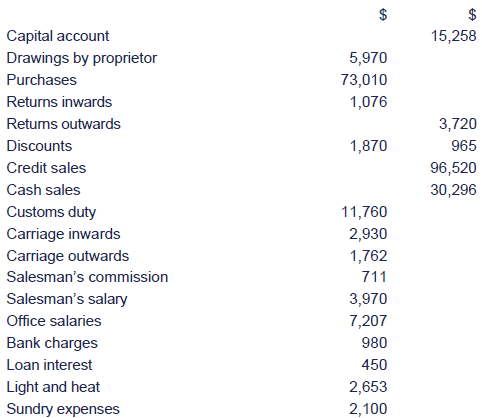
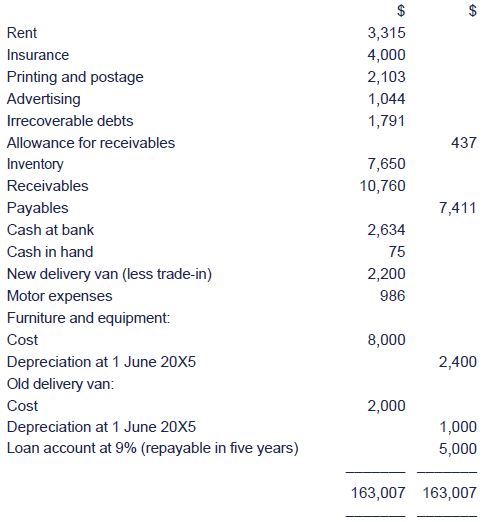
The following information is relevant:
(1) Closing inventory has been valued for accounts purposes at $8,490.
(2) The motor van was sold on 31August 20X5 and traded in against the cost of a new van. The trade-inprice was $1,400 and the cost of the new van was $3,600. No entries haveyet been made for this transaction apart from debiting the $2,200 cashpaid to the New delivery van account.
(3) Straight-line depreciation is to be provided on a monthly basis at the following annual rates:
Motor vans 25%
Furniture and equipment 10%
(4) Past experience indicates that an allowance for receivables should be made equivalent to 5% of the closing receivables.
(5) An accrual of $372 is required in respect of light and heat.
(6) A quarter’s rent to 30 June 20X6amounting to $900 was paid on 2 April 20X6. Insurance for the year to31 March 20X7 amounting to $1,680 was paid on 16 April.
Prepare an income statement and a statement of financial position for the year ended 31 May 20X6.


 Solution
Solution
Solution
Step 1 Inventory
The closing inventory figure of $8,490 must be included in the financial statements. The accounting journal is:
Dr Inventory (SFP) $8,490
Cr Inventory (Cost of sales in IS) $8,490
Step 2 Non-current assets and depreciation
As well as calculating the depreciation for the year, we must also deal with the part-exchange of the van during the year.
Depreciation of van from 1 June 20X5 to 31 August 20X5:
Cost $2,000 x 25% x 3/12 = $125
Disposal of van:
The van has been part-exchanged against the cost of a new van.The trade-in value of $1,400 is equivalent to the disposal proceeds ofthe van. The new van has a total cost of $3,600 consisting of $1,400trade-in allowance and $2,200 cash.
The double entry to record the disposal is:
Dr Delivery van accumulated
depreciation account ($1,000 + 125) $1,125
Dr New delivery van cost account $1,400
Cr Delivery van cost account $2,000
Cr Profit on sale of asset $525
This can be shown in the disposal account as follows:

Don’t forget to add on the depreciation for the first threemonths of the year when you are calculating the profit on disposal.
Note that this question specifically requires monthly depreciation.Some questions may state that there is no depreciation in the year ofacquisition or year of disposal of an asset. Make sure you read thequestion carefully.
Depreciation of van from 1 September 20X5 to 31 May 20X6:
Cost $3,600 x 25% x 9/12 = $675.
The total depreciation for the year for delivery vans is $800 (675 + 125).
Depreciation on furniture and equipment:
Cost $8,000 x 10% = $800.
Step 3 Irrecoverable debts
- The TB shows us that:
- $1,791 has been written off in the year for irrecoverable debts; and
- the balance on the allowance for receivables is $437.
The closing allowance should be 5% of closing receivables.
The charge to the income statement is the movement between the opening and closing allowance.
$538 – $437 = $101 increase in the allowance which is debited to the income statement.
The double entry to record this transactions is:
Dr Irrecoverable debts expense $101
Cr Allowance for receivables $101
The charge in the income statement for irrecoverable debts willamount to $1,892 including the debt already written off ($1,791 + $101).
Step 4 Light and heat
$372 needs to be accrued for light and heat expenses. The double entry is:
Dr Light and heat expense $372
Cr Current liabilities $372
This journal entry ensures that the business has recorded all of its expenses in the period.
Step 5 Rent
The rent has been paid in advance and part of the payment relatesto the next accounting period. This must be taken out of expenses forthe current period and shown in the statement of financial position as aprepayment.
Rent prepaid (1/3 x $900) = $300
Step 6 Insurance
Insurance has also been paid in advance and must be adjusted.
Insurance prepaid 10/12 x $1,680 = $1,400
Step 7 Prepare the income statement and statement of financial position
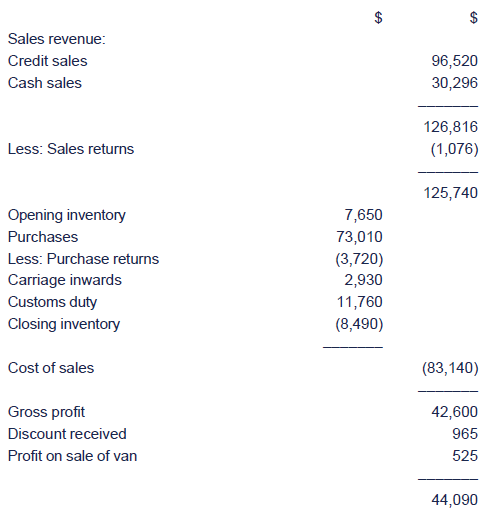
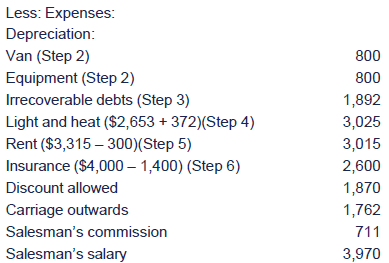
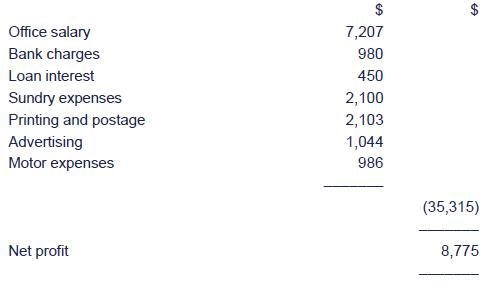
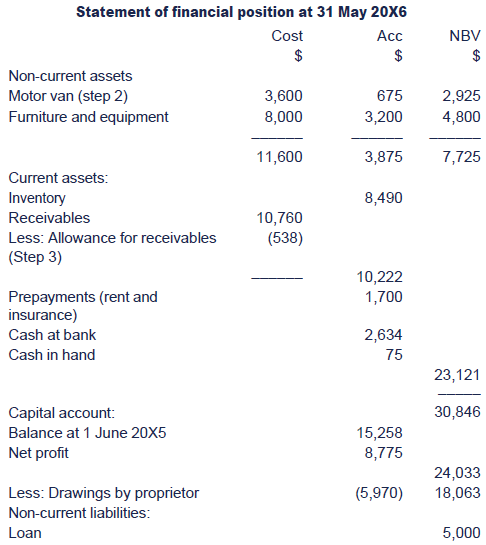
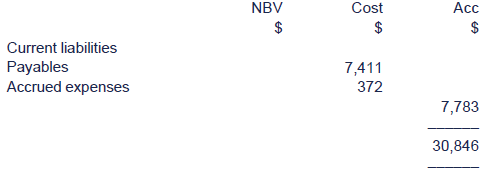


 Test your understanding 1
Test your understanding 1
Kevin Suri carries on business as a retail trader. The trial balance of his business as at 31 December 20X5 was as follows:


You are given the following additional information:
(1) Inventory at 31 December 20X5 was $25,680.
(2) Rent was prepaid by $1,000 and light and heat owed was $460 at 31 December 20X5.
(3) Land is to be revalued to $250,000 at 31 December 20X5.
(4) Following a final review of thereceivables at 31 December 20X5, Kevin decides to write off another debtof $130. He also wishes to maintain the allowance for receivables at 3%of the year end balance.
(5) Depreciation is to be provided as follows:
(a) building – 2% annually, straight-line
(b) fixtures & fittings – straight line method, assuming a useful economic life of five years with no residual value
(c) motor vehicles – 30% annually on a reducing balance basis.
A full year’s depreciation is charged in the year of acquisition and none in the year of disposal.
Prepare an income statement for the year ended 31 December 20X5 anda statement of financial position as at that date for Kevin Suri.

Chapter summary
Test your understanding answers

 Test your understanding 1
Test your understanding 1
Kevin Suri Income statement for the year ended 31 December 20X5


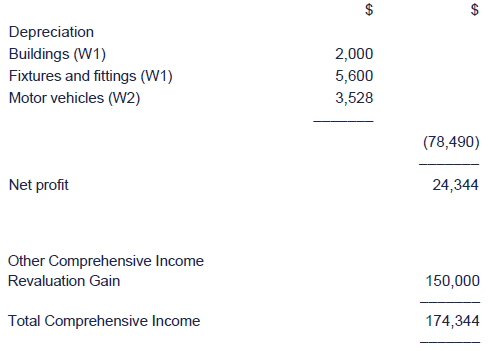

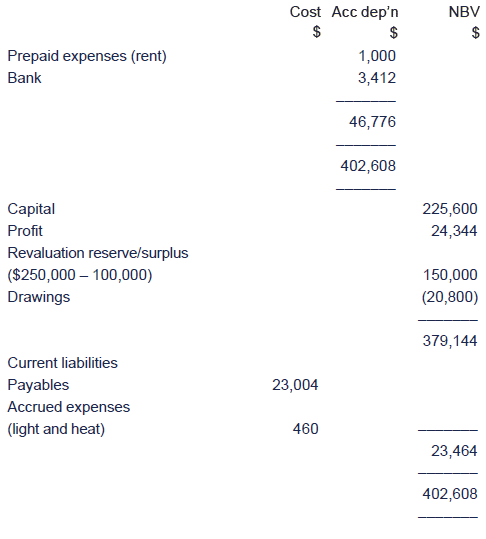
Working
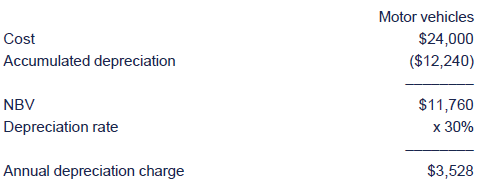

|
Created at 5/24/2012 3:33 PM by System Account
(GMT) Greenwich Mean Time : Dublin, Edinburgh, Lisbon, London
|
Last modified at 5/25/2012 12:53 PM by System Account
(GMT) Greenwich Mean Time : Dublin, Edinburgh, Lisbon, London
|
|
|
|
 |
Rating
:
|
 Ratings & Comments
(Click the stars to rate the page) Ratings & Comments
(Click the stars to rate the page)
|
 |
Tags:
|
|
|
|
|